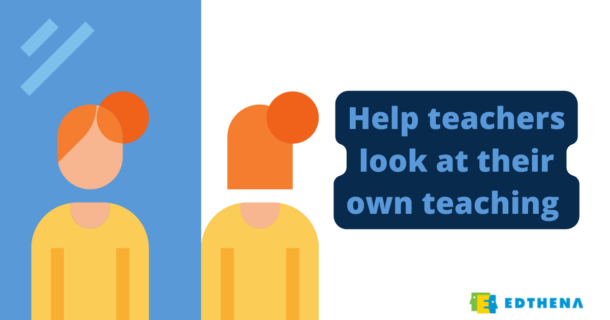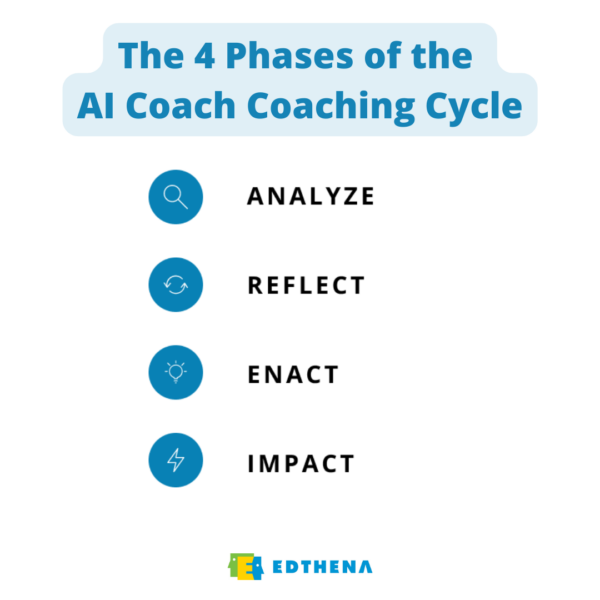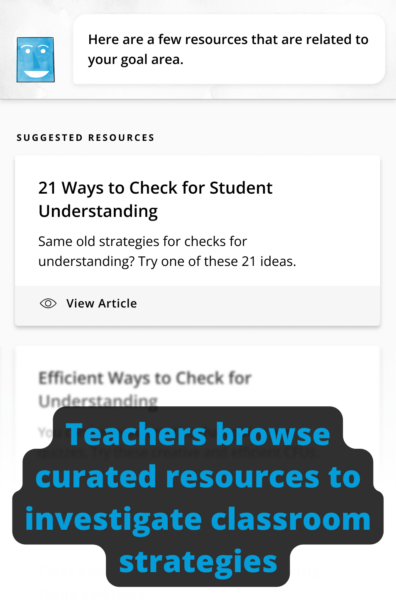How AI Coach Self-Reflective Coaching Cycles Can Accelerate Growth for Teachers

Reality check: Are teachers engaging in coaching cycles on a regular basis? The truth is, many schools often don’t have enough coaching capacity to put a coach in every classroom every day to support teachers’ continual improvement.
But we know that teachers can and should continue their professional learning and growth for positive student outcomes.
Imagine a third-grade teacher working on multiple skills with their existing instructional coach. They can’t wait the weeks, or even months, in between observations and feedback from a coach to get better for their students.
Now, teachers can improve on a chosen skill on their own to accelerate their growth.
The AI Coach by Edthena guides teachers through a four-phase coaching cycle. Each phase is key to teachers’ learning and work toward an instructional goal, and we’re here to break down each of the four phases.
The AI Coach platform implements a coaching cycle process
The AI Coach by Edthena coaches teachers to coach themselves, so they can keep working on their growth areas between opportunities to collaborate with their instructional coach or colleagues.
In many effective coaching models, coaches follow a conversation protocol asking educators probing questions that help prompt teachers’ thinking and goals around growth. The AI Coach platform recreates the conversational experience between coach and teacher.

Teachers converse with a virtual coach named Edie about their learning priorities and enacting change in their classroom that will help them make progress on their goals for student outcomes.
Edie guides teachers in a structured process through the four phases of the AI Coach coaching cycle:
- Phase 1: Analyze. Guided by the virtual coach’s personalized observation tips, teachers analyze their teaching videos with goal-aligned, timestamped comments.
- Phase 2: Reflect. The virtual coach prompts teachers to reflect on their analysis and develop a near-term goal in their professional growth priority area.
- Phase 3: Enact. Teachers develop an action plan to enact in the classroom with curated resources from the virtual coach.
- Phase 4: Impact. The virtual coach supports teachers to identify the impact of their action plan and learnings for future professional growth.
The whole process — from analyzing a teaching video to reflecting on near-term goals to enacting change to assessing impact — takes about two weeks.
That’s everything teachers would do with an in-person coach, done on their own.
Phase 1: Analyze
Teachers start by analyzing the evidence of their teaching practice
It’s proven that teachers increase their effectiveness by watching and learning from videos of their own teaching practice.
Teachers seeing what’s really going on in their classroom is key to understanding what’s working … or what’s not.
That’s why the first phase of the AI coaching cycle is Analyze. After capturing and uploading a teaching video of their choosing, teachers can begin to analyze it by adding time-stamped comments of their strengths and noticings, guided by the virtual coach’s personalized observation tips.
Analysis can be difficult because classrooms are complex, and there are many areas teachers can pay attention to for their teaching and learning.
With the AI Coach platform, the teacher is guided to focus their attention before they even begin observing their video, just like they’d do if they were talking with an in-person coach.
The coaching cycle is designed to support teachers of all experience levels because it lets them personalize the coaching topics to their particular interests and needs.
A third-grade teacher may want to focus on “checks for student understanding” (CFUs) and “providing student feedback.”
Edie, the virtual coach, provides the teacher with personalized video observation questions specific to those areas to ask themself, such as, “How often am I checking for understanding throughout the lesson?” and “How am I communicating clearly with students about their growth areas?”
With this observation guidance, the teacher can hone their analysis and leave time-stamped comments at specific moments that are related to CFUs and providing student feedback.
Phase 2: Reflect
Teachers reflect on their teaching to determine a goal area for change
There can be a lot to consider when reviewing videos of classroom teaching. Teachers are often overly critical of their own practice and find several areas that need their attention for improvement.
After teachers finish leaving comments on their teaching video in the Analysis phase, the AI Coach platform supports teachers to look to the big picture and set a goal in the Reflect phase.
Edie prompts teachers to review their comments and synthesize the trends and patterns they see. It’s possible that the teacher now identifies multiple areas for improvement.
However, it’s important for teachers to identify one goal to take action on. Trying to change too much at once doesn’t lead to effective growth and many popular coaching models rely on encouraging teachers to focus on one thing at a time.
So, just like an in-person coach, the virtual coaching process guides teachers to select a single skill area as an opportunity for growth. Once the professional learning interest is identified, then the teacher works with the virtual coach to define an actionable goal.
Edie doesn’t simply ask, what is your goal? In addition, the virtual coach asks the teacher probing questions to define the goals in terms of their bigger-picture professional learning priorities and the potential impact on students.
For example, perhaps our teacher’s desire is to engage a wider variety of students during guided practice to confirm students’ readiness for independent practice.
The third-grade teacher is asked what will be changed in student outcomes when more students are demonstrating understanding, how this change is measured, and why this skill area is important for the teachers’ definition of success.
Edie’s prompts and questions support teachers to feel invested in and in charge of their growth by pinpointing what they’re aiming to achieve and why.
Having this goal set also supports teachers to develop a clear strategy in the next phase of the coaching cycle.
Phase 3: Enact
Teachers affect student outcomes when they enact a change
Merely reflecting on and identifying a goal for improvement aren’t enough if action doesn’t actually follow.

Building off the goal set during the Reflect phase, teachers develop an action plan within the Enact phase with curated resources from the virtual coach.
If the teacher has a strategy in mind they’d like to try, Edie will capture their next step plan.
But for teachers who are in need of some new ideas or interested in deeper learning, Edie can offer curated resources aligned to the professional skill area of the goal.
For example, with a resource like 21 Ways to Check for Student Understanding, the third-grade teacher will have a jumping-off point for trying new strategies with their students.
Perhaps they decide to use more think-pair-share’s and exit tickets as a way to check more students’ knowledge.
When teachers are done defining their strategy for action, Edie sends a summary of everything to the teacher via email, similar to an instructional coach providing notes from a conversation for accountability.
Teachers now take a short break, for a few days or a week, from the AI Coach coaching cycle to enact changes in their classroom.
Phase 4: Impact
Teachers measure the impact of their action steps in the final phase of the AI Coach coaching cycle
The AI Coach cycle of inquiry is not finished simply because the teacher has taken action in their classroom. It’s important for teachers to ask themselves, “What happened when I made that change, and is it worth continuing?”
Enter Edie, the virtual coach, who schedules a check-in with the teacher to learn about the results of the teacher’s next-steps-plan and the implications for future learning.
In the Impact phase, the AI Coach platform supports teachers to consider and describe the impact of their action plan and implications for future professional learning.
The third-grade teacher needs to know if implementing new strategies related to checking for student understanding helped them more accurately assess student mastery.
The teacher also needs to determine whether they should continue with these strategies. By responding to Edie’s targeted questions, the teacher assesses the success of their changes to determine what to do or not do moving forward.
In this way, the Impact phase is rooted firmly in our belief that any single coaching cycle does not have a fixed endpoint — learning is an ongoing process.
The AI Coach coaching cycle helps teachers maintain the “continue” in their continuous learning because they are looking beyond a one-time fix for their classroom and engaging in long-term professional growth.
Finishing a coaching cycle is the beginning of more learning
Through the four phases of the AI Coach coaching cycle, teachers work on a specific goal and developed a short-term action plan. They’ve enacted change in their teaching practice and determined the impact of the changes.
The whole coaching cycle process helps teachers see how they can learn and grow between time spent with their colleagues within their building. This supports teachers to continually increase their effectiveness. It also prepares them to be better collaborators with their coach and with other teachers in PLCs.
Teachers, with the help of the virtual coach, are learning the process of analyzing their own teaching video, reflecting on and identifying a near-term goal, enacting a selected strategy to meet that goal, and then assessing the impact of their action.
Each AI Coach coaching cycle helps teachers accelerate their own growth.
Learn more about the AI Coach platform here. Want to try it out for yourself? Sign up for access here.
